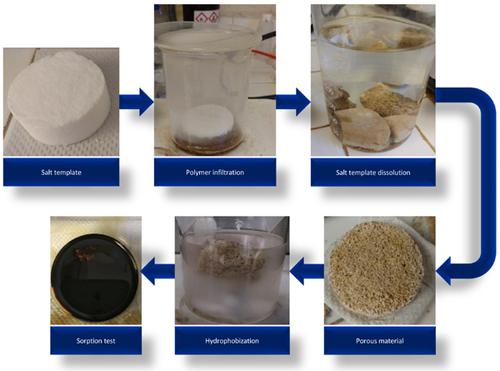Recent Patents on Nanotechnology ( IF 2 ) Pub Date : 2020-08-31 , DOI: 10.2174/1872210514666200207112215 Cynthia E I Torres 1 , Thelma S Quezada 1 , Israel López 1 , Idalia G de la Fuente 1 , Francisco E L Rodríguez 2 , Oxana V Kharissova 3 , Boris I Kharisov 1

|
Aims: The purpose of this work was to obtain a hydrophobic sorbent material with potential applications in oil spill remediation.
Background: The accidents due to oil spills cause long-term ecological damage, especially in the aquatic environment. The cleaning of oil spills can be carried out by many methods and techniques, being absorbents the most attractive due to the possibility of recovery and complete elimination of the hydrocarbons in situ from the water surface. In recent years, interest in polymeric materials for oil spill remediation has increased due to its low cost, high stability, and recyclability.
Objective: The objective of this work was the development of sorbent materials based on polymer wastes, such as Polyethylene Terephthalate (PET), obtained from recycled bottles, and recycled Polyurethane (PU), for its application in the recovery of oil spills.
Methods: Sorbent materials were prepared from polymer wastes, using salt molds for the formation of porous materials with a composition of PU of 5, 10 and 15%, which were subsequently hydrophobized using carbon nanotubes or silica nanoparticles by dip-coating technique.
Results and Discussion: The obtained hydrophobic sorbent materials were characterized by Scanning Electron Microscopy (SEM) and Infrared Spectroscopy (FTIR). The resulting absorbent has shown capacity to separate oil from water; the best result was obtained by the sponge of PET-PU (10% PU) hydrophobized with a suspension with low multi-wall carbon nanotubes (MWCNTs) concentration, obtaining an absorption capacity of 2.01 g/g.
Conclusion: Besides the standard sorption capacity, these cheap sorbent materials had interesting properties like low density, high hydrophobicity and buoyancy, which could be applied in other applications related to solving oil spills.
中文翻译:

基于聚合物废料及其化合物与纳米材料的吸附剂材料的开发,用于溢油修复。
目的:这项工作的目的是获得一种疏水吸附剂材料,在溢油修复中具有潜在的应用前景。
背景:漏油事故造成的长期生态损害,特别是在水生环境中。溢油的清理可以通过许多方法和技术来进行,由于可能从水面回收和完全清除碳氢化合物,因此吸收剂最为吸引人。近年来,由于其低成本,高稳定性和可回收性,人们对用于溢油修复的聚合物材料的兴趣增加了。
目的:这项工作的目的是开发基于聚合物废物的吸附剂材料,例如从回收瓶中获得的聚对苯二甲酸乙二酯(PET)和回收聚氨酯(PU),以用于溢油回收。
方法:使用盐模从聚合物废料中制备吸收性材料,以形成PU含量为5、10和15%的多孔材料,然后使用碳纳米管或二氧化硅纳米颗粒通过浸涂技术对其进行疏水化处理。
结果与讨论:所得疏水性吸附剂材料通过扫描电子显微镜(SEM)和红外光谱(FTIR)进行表征。所得的吸收剂显示出将油与水分离的能力。通过用低多壁碳纳米管(MWCNT)浓度的悬浮液疏水化PET-PU(10%PU)海绵获得的最佳结果,吸收容量为2.01 g / g。
结论:除了标准的吸附能力外,这些廉价的吸附剂材料还具有低密度,高疏水性和浮力等令人感兴趣的特性,可用于与解决溢油有关的其他应用中。



























 京公网安备 11010802027423号
京公网安备 11010802027423号